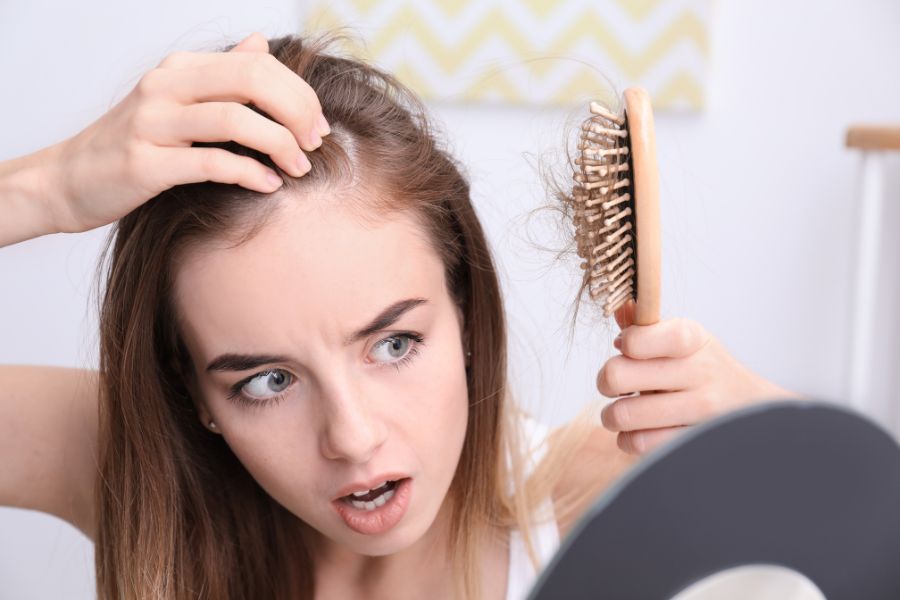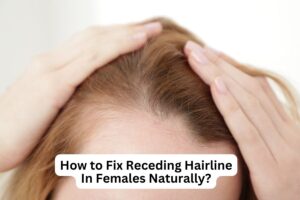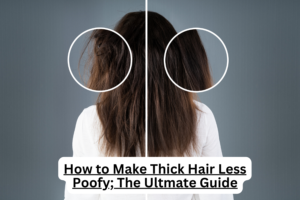Regrow Hairline… It’s a phrase that resonates with countless individuals seeking to address the common concern of receding or thinning hair. In a world where appearances often hold significant weight, maintaining a full and healthy hairline can be a source of confidence and self-assurance. The quest to regrow a receding hairline is a journey marked by a myriad of options, from natural remedies to advanced medical treatments.
In this article, we will explore the fascinating world of hair regrowth, delving into the science, the myths, and the promising solutions that offer hope to those on this path. So, if you’ve ever wondered about the secrets to a rejuvenated hairline, join us on this captivating exploration of possibilities. Your quest for a fuller, more vibrant hairline begins here.
Check out our latest post:
- How to Make Thick Hair Less Poofy; The Ultmate Guide
- How to Make Your Hair Less Poofy Naturally; 7 Killer Tricks To Tame It
- How To Apply Face Primer Like A Professional Makeup Artists; 6 Hacks
- How Can Ponytails Cause Headaches & Suck the Life Out of You
Is it possible to regrow the hairline?
The short answer is yes, it is indeed possible to regrow a hairline, but the effectiveness of regrowth largely depends on various factors, including the underlying cause of hair loss, genetics, age, and the chosen method of treatment.
Hair loss can occur for a range of reasons, such as genetics (male and female pattern baldness), hormonal imbalances, medical conditions, or even stress. While some individuals may experience natural regrowth with lifestyle changes, such as improved nutrition and stress reduction, others may require more advanced interventions like medications, hair transplant surgery, or laser therapy to stimulate regrowth.
It’s essential to consult with a healthcare professional or a dermatologist to assess the specific cause of your hair loss and determine the most suitable approach to regrow your hairline effectively.
Check out: How to Fix Receding Hairline In Females Naturally
Tips to regrow hairline
1. Proper Hair Care and Maintenance:
Maintaining a healthy hairline begins with good hair care practices. Be gentle with your hair to prevent further damage or breakage. Avoid tight hairstyles that stress the hair follicles, and use a wide-toothed comb to detangle wet hair. Overwashing can strip your scalp of natural oils, so find a balance that works for your hair type and lifestyle.
2. Balanced Diet and Nutritional Support:
A well-rounded diet rich in essential nutrients can promote hair health. Incorporate foods high in biotin, vitamins A and C, zinc, and omega-3 fatty acids, as they support hair growth and strengthen follicles. Supplements can be an option if your diet lacks these nutrients, but consult a healthcare professional before starting any supplementation.
Check out: Home made Sea Salt Hair Spray
3. Scalp Health and Massages:
A healthy scalp is the foundation for a thriving hairline. Regularly cleanse your scalp to remove excess oil and debris. Scalp massages can stimulate blood flow and help distribute natural oils. You can also explore the use of essential oils like rosemary or peppermint, which are believed to promote hair growth.
4. Avoid Harsh Hair Products:
Steer clear of hair products containing harsh chemicals or excessive heat styling. These can weaken your hair and lead to further hair loss. Opt for gentle shampoos and conditioners, and limit the use of heated styling tools.
5. Medical and Professional Treatments:
For more severe cases of hair loss, consult a dermatologist or hair restoration specialist. They can recommend medical treatments like minoxidil or finasteride, as well as advanced procedures such as hair transplant surgery or low-level laser therapy. These options are tailored to individual needs and can yield significant results.
Remember, regrowing a hairline is often a gradual process that requires patience and consistency. What works best for one person may differ from another, so it’s essential to explore various strategies and, if needed, seek professional guidance to find the most effective approach for your specific situation.
What causes a receding hairline?
Understanding the causes of a receding hairline is crucial for those dealing with hair loss concerns. While it’s a common issue that affects many individuals, the underlying factors can vary widely. Here, we’ll explore some of the primary reasons behind a receding hairline, shedding light on the diverse triggers that contribute to this widespread condition.
1. Genetic Predisposition: Genetics plays a significant role in hair loss, particularly when it comes to receding hairlines. If you have a family history of male or female pattern baldness, you may be genetically predisposed to develop a receding hairline. Hormones play a role in this type of hair loss, which can affect both men and women as they age.
Check out: How to Moisturize Low Porosity Hair; 10 Successful Tips to Try
2. Hormonal Changes: Hormonal fluctuations can trigger a receding hairline. In men, the hormone dihydrotestosterone (DHT) is often responsible for shrinking hair follicles, leading to hair thinning and recession. Women may also experience hormonal changes due to conditions like polycystic ovary syndrome (PCOS) or menopause, resulting in hair loss.
3. Age-Related Hair Thinning: As individuals age, their hair naturally undergoes changes. Hair follicles may become smaller and less active, leading to a thinner hairline. This age-related hair thinning is a common cause of receding hairlines in both men and women.
4. Poor Hair Care Practices: Frequent use of harsh hair products, excessive heat styling, tight hairstyles, and overwashing can weaken hair and contribute to a receding hairline. These practices can damage the hair shaft and follicles, leading to hair loss over time.
5. Health Conditions and Medications: Certain medical conditions, such as alopecia areata or thyroid disorders, can result in hair loss, including a receding hairline. Additionally, medications like chemotherapy drugs or anticoagulants may cause hair thinning as a side effect.
Identifying the specific cause of your receding hairline is crucial for determining the most appropriate treatment or prevention strategies. Consulting with a healthcare professional or dermatologist can help pinpoint the underlying factors and guide you toward effective solutions for managing hair loss.
Check out: My Hair so Thin Can See My Scalp; What to Do?
How do I reduce hairline loss? Receding hairline treatment
Addressing hairline loss and seeking effective receding hairline treatment can be a matter of concern for many individuals. The good news is that there are various strategies and treatments available to help reduce hairline loss and promote regrowth. Here, we’ll explore some practical steps and treatment options for those looking to combat this common issue.
1. Healthy Lifestyle Choices:
Maintaining a healthy lifestyle can play a significant role in reducing hairline loss. Adequate sleep, stress management, and a balanced diet rich in essential nutrients can support overall hair health. Nutrients like biotin, vitamin D, and omega-3 fatty acids are known to promote hair growth and reduce hair loss.
2. Gentle Hair Care Practices:
Be gentle with your hair to prevent further loss. Avoid tight hairstyles that place stress on hair follicles and use a wide-toothed comb to detangle wet hair. Overwashing can strip your scalp of natural oils, so find a washing frequency that suits your hair type and lifestyle.
Check out: How to Avoid Dandruff in Winter Naturally; 5 Ways
3. Topical Treatments:
Over-the-counter topical treatments like minoxidil can stimulate hair follicles and promote hair regrowth. These products are available in various strengths and formulations and can be a part of a comprehensive receding hairline treatment plan.
4. Prescription drugs:
A medical professional might advise taking prescription drugs like finasteride to stop hairline loss. Finasteride works by reducing the hormone dihydrotestosterone (DHT), which is often responsible for shrinking hair follicles.
5. Platelet-Rich Plasma (PRP) Therapy:
PRP therapy involves drawing a small amount of your blood, processing it to concentrate the platelets, and injecting it into the scalp. This treatment can stimulate hair follicles and promote hair regrowth, making it a popular choice for some individuals.
Check out: The right way to Apply Face Primer
6. Hair Transplant Surgery:
In more advanced cases of hairline loss, hair transplant surgery is a viable option. During this procedure, hair follicles are transplanted from one area of the scalp to the receding hairline, creating a natural-looking result.
7. Consultation with a Dermatologist:
For a personalized approach to receding hairline treatment, it’s advisable to consult with a dermatologist or hair restoration specialist. They can assess your specific condition, recommend suitable treatments, and develop a customized plan tailored to your needs.
Reducing hairline loss and regaining confidence in your appearance is achievable with the right combination of treatments and lifestyle adjustments. Remember that results may vary, and it’s essential to be patient and consistent in your efforts to combat receding hairlines effectively.
Check out: Hair Slugging: Advantages, Historical past & An Skilled-Led How-To
Minoxidil for receding hairline
Minoxidil is a well-known and widely used over-the-counter medication for addressing hair loss, including receding hairlines. It has been a popular choice for those seeking a non-prescription solution to combat hairline loss. Here, we delve into the details of using minoxidil for receding hairlines, exploring its effectiveness and considerations.
1. How Minoxidil Works:
- Minoxidil is a topical medication that comes in liquid or foam forms.
- It enhances blood flow to hair follicles, potentially encouraging hair regrowth.
- Although the exact mechanisms are not entirely clear, it’s thought to extend the hair growth cycle and promote thicker, healthier hair.
2. Application and Usage:
- Applying minoxidil is simple: apply it directly to the scalp, targeting hair loss areas, twice daily.
- Strictly follow product label instructions for best results.
- Significant results may take several months of consistent use.
- Discontinuing minoxidil may result in a return of hair loss, emphasizing the importance of regular use.
Check out: How to Moisturize Low Porosity Hair; 10 Successful Tips to Try
3. Effectiveness:
- Results range from significant hair regrowth to modest improvement or hairline maintenance.
- Typically, it’s more effective for recent or mild hair loss.
- Its efficacy may decrease in cases of advanced hairline recession.
4. Possible Side Effects:
- Common side effects may encompass scalp irritation, itching, and dryness.
- In uncommon instances, individuals may encounter more severe side effects, such as dizziness or chest pain.
- If you experience severe or unexpected side effects while using minoxidil, it’s imperative to discontinue its use promptly.
- Seeking immediate medical advice and consultation with a healthcare professional is crucial to address any concerning side effects effectively.
5. Consultation with a Healthcare Professional:
Before starting minoxidil or any hair loss treatment, it’s advisable to consult with a healthcare professional or dermatologist. They can assess your specific condition, provide guidance on the best treatment approach, and ensure that minoxidil is an appropriate option for your hairline loss.
Minoxidil can be a viable and accessible solution for addressing receding hairlines, offering hope to those looking to regrow and maintain their hair. However, individual responses to the medication vary, and it’s important to use it consistently and as directed for the best chance of success. Consulting with a healthcare professional can help you determine whether minoxidil is the right choice for your specific hair loss needs.
Check out: What Is The Best Oil For Hair Slugging? For Normal & Thick Hair
Conclusion
In conclusion, the quest to regrow a receding hairline is a journey that can be both hopeful and challenging. While there are various approaches and treatments available, including minoxidil, for combatting hairline loss, it’s important to remember that individual results may vary. The effectiveness of these methods often depends on factors such as the underlying cause of hair loss, genetics, and consistency in treatment.
Whether you choose minoxidil or another approach, seeking guidance from a healthcare professional or dermatologist is a prudent step to tailor a solution that suits your specific needs. The journey to regrow a receding hairline is about patience, persistence, and finding the right strategy to help you achieve the fuller, more confident look you desire.





